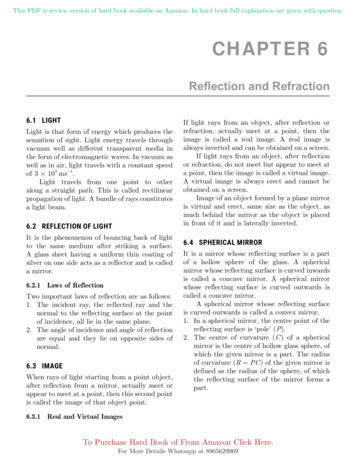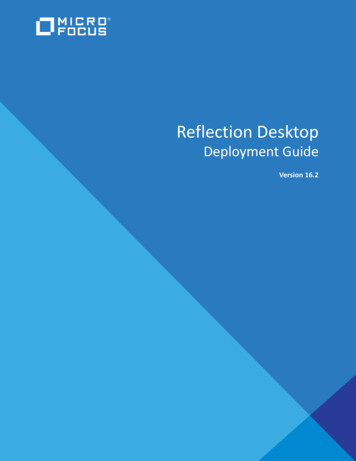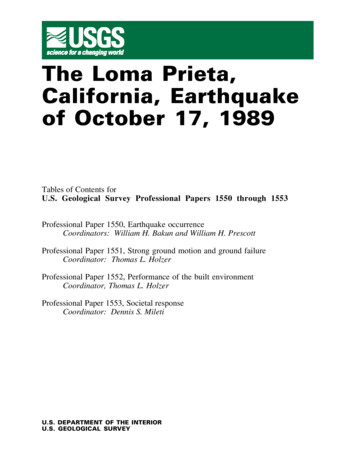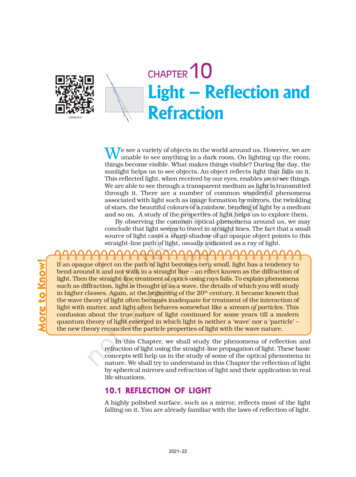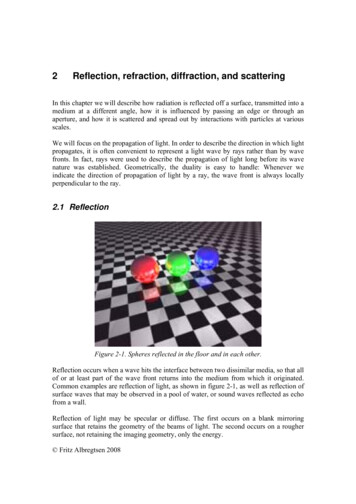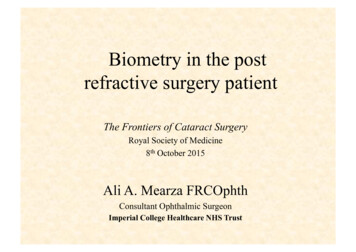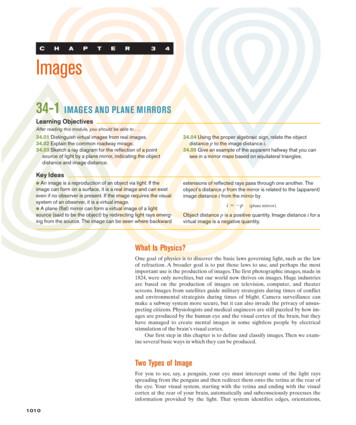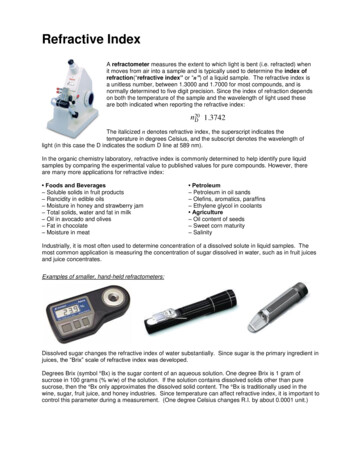
Transcription
Northern Beaches Council presentsREFLECTION/ REFRACTIONWarringah Creative Space13 - 24 JulyCade TurnerPeta DzubielKaren StuartRivers Edge by Peta Dzubiel, 2015curated byRachel Carroll1
REFLECTION/REFRACTION13 - 24 JulyThis is an exhibition that explores the uniquelight in our local surroundings by three emergingartists from the northern beaches. Each artist isdedicated to their chosen media - photography,oil painting and ceramics.OPENING NIGHTThurs 14 July, 6 - 8pmMEET THE ARTISTS/Q & ASun 24 Jul, 1 - 2pmEXHIBITION OPENING TIMESWed-Sun, 10-4pmLight can give you back your history, not only as a thought or memory but as a vital andintense experience.it strongly influences the sentiment with which you experience your reality.HuismanThis exhibition Reflection/Refraction bringstogether three Sydney based artists who enhanceour memories of reality with light. As the quotesuggests, light can greatly influence our experienceof a place or event. Each artist touches on certainevents that reflect the environmental changesin our atmosphere, oceans and waterways.Each artist highlights the nature of an everydayexperience; a lake, the ocean floor and cloudformations, but they are asking us to questionthese surrounds from an environmentalperspective.Cade Turner’s black and white photographs ofclouds titled Cielo allow the light to enhanceform and movement, while his photo seriestitled Away explores a nostalgic relationshipwith nature in a soft and hazy light. Peta Dzubielpaints lush oils of lakes titled Arcadia, wherethe fading light is reflected by the water surface.Peta’s new figurative work harks back to a timewhen nature was experienced at a distance or assomething to conquer. While the detailed ceramicsby Karen Stuart engage present concerns forcoral bleaching. The light filled coral ceramics areenhanced by a subtle use of colour, the series istitled SEA. Each artist, independent of each other,has explored the variety of light found in eachlocation.Burke was the first philosopher to argue that thesublime and the beautiful are mutually exclusive.(1756)Warringah Creative Space105 Abbott RdNorth Curl Curl2Each location has a story that intermingles aRomantic and impressionistic visual language.Historically Romantic Artists were concerned withthe power of nature and the sublime experience itprovided. Here each artist is providing a sublimeexperience but one that is not about nature’spower but instead they highlight the beautyand greatness of nature’s liquid paths. Theimpressionistic light reflected in each artworkreveals a considered observation of a glow or themovement of time and it allows the immersiveexperience to take hold.Delicate seaweed and coral evokes memoriesof the ocean floor. Are these Ceramics of coralthat are globally warmed and bleached?Photograph’s of the light bouncing off a cloudquickly establishing a sense of form. Is this ouratmosphere, how clean is it and how warm isit? Numerous questions are provoked by theseartworks often with an underlying concern for theenvironment.The figurative work by both Cade and Petaintertwines place and time with a sense ofnostalgia. Are these relationships with naturefrom the past or are they relationships we shouldbe focusing on now? Both artist’s work using twovery different mediums, one the camera and theother oil paint and yet the vision they both sharereflects one of atmospheric deliberation. In eachview you are drawn to colour, movement and thesubtle form, but you are left to draw your ownconclusions, what is actually going to happen,what has happened or what just is.In today’s climate eco-criticism is leading the wayoffering new ways to examine our concerns andrelationships with nature, equally art is taking alead by providing a pedagogical experience toinspire us to engage with nature. Each artist invitesus to observe the light and the details that are areminder of what is and what will hopefully remain.If we all learn something from the experience ofviewing these artworks, if we can view nature in anew light and seek a new relationship with naturethen these artworks have been prodigious.Rachel Carroll3
Cielo I, 2013Interview with Cade TurnerWhen did you start creating and whichteacher/s influenced your practice?I have been creating for as long as I canremember. Although I didn’t start photographyuntil I was 20 I have been highly creative withwriting music, Lego and drawing from a veryyoung age. I am mostly influenced by romanticartists in music and in the visual arts, namelyBeethoven, Erik Satie, Pink Floyd, JMW Turnerand Monet.What do you want to achieve with paint/photography/ceramics that you haven’t alreadybeen able to achieve?Photography is traditionally seen as a twodimensional medium. I am keen to explore thehidden third dimension in photography. That isthe ability to get very tactical and experiential inmy work and create highly immersive, moving4and beautiful experiences that leaves us with alasting impression and deeper contemplation ofthe essence of life itself.Bilgola, to light bouncing off an old plastic drum,in search of hidden stories of light. I also findmusic a powerful source of creative insight.What artist has influenced you the most?Monet and Turner. Their work moves me like noother.What can painting/photography/ceramics dothat other art-forms are unable to?Photography allows us to see what the eyecannot see. It allows us to capture what liesunderneath reality, sometimes only 2 degreesfrom what we naturally see, and sometimesexposing worlds of complete visual wonder andabstraction.I also enjoy exploring other mediums of art.There are always insights and ideas that can beuniquely channelled and transposed through thelens. I also compose music for piano and havedone since I was ten.How do you start a painting/photograph/ceramic? Do you draw foundations and buildfrom there, or do you just start with paint/photo/ceramic? Do you make preliminarydrawings?Traditionally, I start with a concept or blueprintof what I want to explore. Sometimes I amguided by a new idea or technique. However, Iam completely at the mercy of my intuition andconnection to the environment and surroundsin which I am working. Sometimes I captureexactly what I had premeditated, but more oftenthat not, I find myself discovering and unveilinghidden wonders of light that are spontaneous.What is your favourite work of art?I equally find visual beauty in music andmusic in visual works, so I rarely distinguishbetween mediums. I don’t have a particularfavourite visual work but I find JMW Turner’slast lightscapes in watercolour truly inspiring powerful and dynamic yet delicate and free all atthe same time. In music, Beethoven’s MoonlightSonata, Erik Satie’s ‘Gnosseine’ and Pink Floyd’s‘Shine on you crazy diamond’ are classics thathave always resonated with me. You will oftenfind me listening to these while I am creating mywork, or perhaps Alfred Hitchcock’s theme from‘Vertigo’, written by Bernard Hermann which Ibelieve is the mastery of mystery.Do you think about work you have previouslymade? Does it leave your head once you havecompleted it or does it continue to develop intonew work?As a photographer, the work is seeminglycompleted in an instant. So, I spend a lifetimereviewing and going back over my work timeand time again. It helps me understand whoI am, connects me to my own inner truth andreconfirms where I am going next.Cielo IV, 2013What are your creative influences?At my core, I am a romantic. As such, I aminspired by works that are anything fromtwo centuries old to the latest contemporaryinterpretations of romanticism and abstraction.I am mostly inspired by painters and artists ofother mediums, outside of photography.What other forms of creative expression do youenjoy that feeds your creativity?I love exploring how light bounces off or passesthrough all sorts of subject matter. From theendless palette of colour that passes through thenative flowers and leaves around our house in5
Are the figures determined by the landscape orvice versa? Do you see the image first in yourhead or build it on the painting surface as youwork?I build my visual story as I work the scene.Explain the current theme you are workingwith.I am fascinated by light and and the endlesspalettes, mystery and unique stories it creates.I am exploring light as the subject, freeing itfrom its living stasis, depicting the intangible astangible, and exposing new visual dimensionsand wonders of reality.Do you use other materials as source materialor as reference?I use paintings and music.Cielo II, 2013What role does memory play in your work?My childhood has never left me. I see the worldno different to when I was three, especially whenI am shooting. This is a central to my creativeprocess.Do you work Plein Air? If so which is easier working in the studio or en plein air? Is thelatter more immediate, or does it requirefollow-up work in the studio?Working plein air is my strength. There is nosubstitute for working with natural light. As Ishoot everything ‘in-camera’, the only followup work in the studio is to review what I havecaptured. It’s either there or it isn’t!Tell me more about the underlying meaningin your work, especially any references to anarrative and/or history.I am particularly interested in exposing thehidden mysteries of light. I am following in thefootsteps of the Pictorialists, the founders ofImpressionist photography and continuing theirlegacy to see photography as a true form of art,no less than painting or sculpture.6www.cadeturner.comInterview with Peta DzubielWhen did you start painting and whichteacher/s influenced your practice?I started my BFA at the College of Fine Arts whenI was 19 in 2003. I always loved and felt drawnto landscape painting, so I was very happy tohave Ian Grant as a painting lecturer. I was alsovery lucky to have the late Alan Oldfield duringmy first year and he had a great rapport withstudents. He introduced us to the technicalaspects of painting, mediums, colour mixing anddifferent supports on which we could work on.I used to paint a lot on primed cardboard as itwas economical and gave a nice effect. I also hadAndrew Christofides, Idris Murphy, Peter Sharpeand Nicole Ellis and they made us examineour work conceptually. Sally Clarke and DavidEastwood ran dynamic workshops which I reallyenjoyed. During my Honours year I had ChelseaLehmann as a supervisor and her influence,support and friendship has remained strong.Chelsea has been a mentor to me and much ofmy knowledge of painting and confidence as anartist stems from her teaching.What do you want to achieve with paint thatyou haven’t already been able to achieve?I want to paint larger figurative work and keepexploring new colour palettes. I want to be moreexpressive but detailed too. It’s a conundrum!What can paint do that other art-forms areunable to?I think there are many reasons painting is stillon the radar as a valid art form. Painting canrender an emotional response unlike any othermedium whether it be by representational ornon-representational means. Colour, texture andtone are several key elements that come intothis. Painting can also deal with brutal subjectmatter with relative sensitivity.River #1, 2015For example, Picasso’s Guernica is an epicpainting that looks at the horrors of humanityduring the Spanish civil war in a way in whichwe can digest and learn from without beingcompletely repelled. But at the end of the dayI think artists who are drawn to paint do sobecause of its materiality and versatility as amedium. There is a level of instant gratificationthat appeals to me. With oil painting, mistakescan be fixed, paintings can be re-worked andthere is a lot of mentally challenging hand/ eyeprocessing that happens. Never a dull momentunless you paint a dull painting!What is your favourite work of art?This is a really hard question for me toanswer as I admire so many artworks, bothcontemporary and traditional. I became quiteteary-eyed when I saw a drawing by Germanartist Kathe Kollwitz in Cologne titled, Womanwith Dead Child. I remember thinking that7
this drawing is so beautiful yet there is suchsadness. How she captured her subject movedme. She was such an incredible artist whocommunicated completely the plight of thelower classes through her expressive anddelicate draughtsmanship. I have always lookedto the impressionists and post impressionistsfor answers to my painting questions. I loveDegas, Streeton, Roberts, Gaugain, Manet, Monet,Whistler, Sorolla the list goes on. I love themall! Australian painting also speaks volumes tome. Arthur Boyd had so many comments abouthumanity with the Australian landscape as thebackdrop. This recontextualised his concernscompletely and gave them new meaning. Genius!What are your creative influences?My creative influences are my artist friends. Theyconstantly inspire and encourage. I love seeingwhat they’re doing and how they manage to staycreative in this fast paced and demanding world.What other forms of creative expression do youenjoy that feeds your creativity?Listening to music is very important for mycreativity in the studio. Walking and immersingmyself within the natural environment whereI can daydream and wander with my thoughtsand plan new paintings. Photography is also awonderful tool that feeds into my practice.Do you think about work you have previouslymade? Does it leave your head once you havecompleted it or does it continue to develop intonew work?No it doesn’t leave my head. It continues toinform my work and can direct a new series ofwork. Often when I paint towards an exhibitionI have many ideas that do not come to fruitionbecause of time limits. So the ideas andpaintings flow on until I get the urge to take anew direction.8What artist has influenced you the most?Different artists have influenced me at differenttimes. I have surely been influenced by Australianimpressionism and contemporary Australianartists but I can’t name just one!How do you start a painting? Do you drawfoundations and build from there, or do youjust start with paint? Do you make preliminarydrawings?I often sketch out my ideas for paintings insketchbooks to nut-out any compositional issuesbefore painting. I generally find if the sketchlooks OK and is working than the painting shouldwork. It has more potential for success anyway.Are the figures determined by the landscape orvice versa? Do you see the image first in yourhead or build it on the painting surface as youwork?Both. I like to have a direction of what I am doingbut also play with the painted surface and trytechniques that will enhance the conceptualmeaning of the work.You currently work figure separate to yourlandscape, would you consider combining thetwo?The figures are always in the landscape but tomake bigger work that deals with the figurein the landscape, yes, I aim to do that. But todo it well and with meaning takes time andexperimentation.Do you use photographs as source material oras reference?I work from references like film stills or historicalphotographs. I also take my own figurativephotographs. Photographs are great for paintersbut I don’t rely on them soley because I don’twish to make static paintings. I want the paintand painting to make the picture and tell thestory. Otherwise what is the point of painting?Do you make stand-alone drawings? (i.e. notjust as studies for paintings?)Yes I do. But often these drawings or elementsof these drawings find their way into paintings.I think this is a natural process if you have painton the brain.What role does memory play in your work?Memory plays a very important role in my work.Conceptually, my paintings are rememberingwho has been in this landscape before now. Mycurrent painting practice explores the tradition oflandscape with a focus on the temporal; the ideathat places remember their past whilst alwaysbeing at the mercy of human intervention andother forces of change.Do you work En Plein Air? If so which is easier- working in the studio or en plein air? Is thelatter more immediate, or does it requirefollow-up work in the studio?Yes I love to paint in situ and then I developthese paintings on a bigger scale in the studio.Working outdoors within the landscape informsyour studio paintings. Working outside has itsproblems, for example, insects and bugs can flyinto your wet painting! I think to paint outdoorsyou have to accept you will get grubby and makea mess and at times it will be uncomfortablewith the hot sun or cold. But if you make a goodpainting it was worth it.Waters Below, 2015Tell me more about the underlying meaningin your work, especially the references to anarrative and history.My paintings work with elements of pictorialambiguity and mystery to explore the landscapeand figure/field relationships as a means bywhich I can express the psychological andmetaphysical aspects of ‘Landscape’.Aluminium Boy, 20169
From its inception the Gothic has dealt withfears and themes which are endemic in thecolonial experience: isolation, entrapment, fearof pursuit and fear of the unknown. And for each,the possibility of transformation, of surviving thedislocation, acts as a driving hope.– Gerry Turcotte, ‘Australian Gothic’, 1998River #3, 2015My current work makes direct reference tonarratives that focus on the notion of being‘lost’ either to a place or by misadventure. PeterWeir’s adaptation of Picnic at Hanging Rock andThe Audrey’s song, Little Molly, have been thebasis for many of the paintings and influencedthe direction my current series. Both referenceshave a psychological connection to landscapeand conjure imagery of people ‘lost’, whether in aphysical or emotional sense, in a place of beautywithin the Australian Landscape. Theoreticallythe Australian Gothic mode is a notion whichresonates with the ideas underpinning my work,in particular the writing of Gerry Turcotte andhis paper, ‘Australian Gothic’, 1998 which hasisolated and described several ideas whichinfluence my practice.10The influence of light, how would you describeit in your artwork?The influence of light plays a very importantrole in my painting. Light for me is experientialand it can conjure memories of time and place.The river and lake environment lends itself toexploring the variations of light in painting, whichin turn affects colour, tone, and the shapes oftrees, sandbanks and reflections. Light createsmood and allows people to engage deeperwith the landscape and fall under its immersivespell. The effects of light can be disorientatingand make you feel off quilter. My work drawsinfluence from Impressionist painting thatendeavoured to capture the emotional andaesthetic experience of nature. It is also inspiredby 19th century Pictorialism, photographersthat painted with light to evoke atmosphere andcapture the essence of a place. My work nodsto these movements by employing gesturalbrushstrokes and a focus on colour and tone torender an atmospheric composition to envelopethe viewer.petadzubiel.comInterview with Karen Stuart (aka Blue)When did you start creating and whichteacher/s influenced your practice?Creativity has always been part of my life, butwith two children, and a mortgage, was alwaysjust a hobby, until 2007, when I had the time andmoney, to study ceramics at Northern BeachesTAFE. I completed a diploma in 2011. The twoteachers that influenced my practice the most,where Walter Auer, an amazingly talented artistand ceramist, with a great sense of humour,who made me believe that I could become anartist. Also Simone Fraser, who has always verygenerously, shared her techniques and dryglaze recipes, with her students, which led meon my path to where I am today, I love the threedimensional form of clay objects, and the factthat it’s a totally natural material, I also love theunpredictable ness, of the finished object, thatcomes with different firing temperatures andglazes, sometimes successful, or not!What is your favourite work of art?My favourite works of art, are by AndyGoldsworthy Land Artist. With his uniquepersonal relationship with nature, and his abilityfor his sculptures to blend into the environment,as if they have always been a part of it. Eventhough they may only exist for a miniscule oftime.What are your creative influences?Going to exhibitions, always feeds mycreativity, whether it’s a painting, sculpture or aphotograph. It can inspire or trigger somethingin your memory, or a different way of seeingsomething.Treasure on the beach, 2016What artist has influenced you the most?Two Japanese ceramicists have inspired methe most. Yukiya Izunita (b.1966) whose workhas razor thin edges, clay torn apart., twistedat impossible angles. His creations exude quietbeauty, tension and a strong connection withnature. Also Nakashima Harumi (b. 1950) with hisfascination with the growing process of plants,he reproduces unique biomorphic sculptures.Do you make stand-alone drawings? (i.e. notjust as studies for ceramics?)I very rarely draw, I mainly see an image inmy head and then try and translate it intoclay, making several Marquette’s and playingaround with different textures, until it resemblessomething like I envisaged. Then the formevolves from there. I do use photographs andphotocopied images as a source of reference,especially for textures.11
My work for the last five years has been inspiredby the ocean, and its intricate life forms and ecosystem. My work continually develops, and ismainly done in a studio environment, or on mydeck at home.Tell me more about the underlying meaningin your work, especially the references to anarrative and history.My work this year is a continuation of lastyear’s work. The human impact on coral reefs,depicting coral as it is today, alive, weakened,bleached and fossilized. World statistics of coralreefs are that a quarter of our reefs, are damagedbeyond repair. Two thirds of reefs are seriouslyunder threat, which leaves very few coral reefs ina healthy condition.Finger coral, 2016Glowing, 201612How is light an influence in your work?With regards to light in my work, I do have afascination with light, its reflective qualities, andthe shadows it creates. At some point I wouldlike to evolve my work and create ceramic pieceswhere the shadow becomes part of the art. I amalso experimenting with some translucent clayat the moment, and when the clay is very thin,strong sunlight, will reflect through it, whichgives the piece a glowing sensation.
OPENING NIGHT Thurs 14 July, 6 - 8pm MEET THE ARTISTS/Q & A Sun 24 Jul, 1 - 2pm EXHIBITION OPENING TIMES Wed-Sun, 10-4pm . artists from the northern beaches. Each artist is dedicated to their chosen media - photography, oil painting and ceramics. Warringah Creative Space 105 Abbott Rd North Curl Curl T
